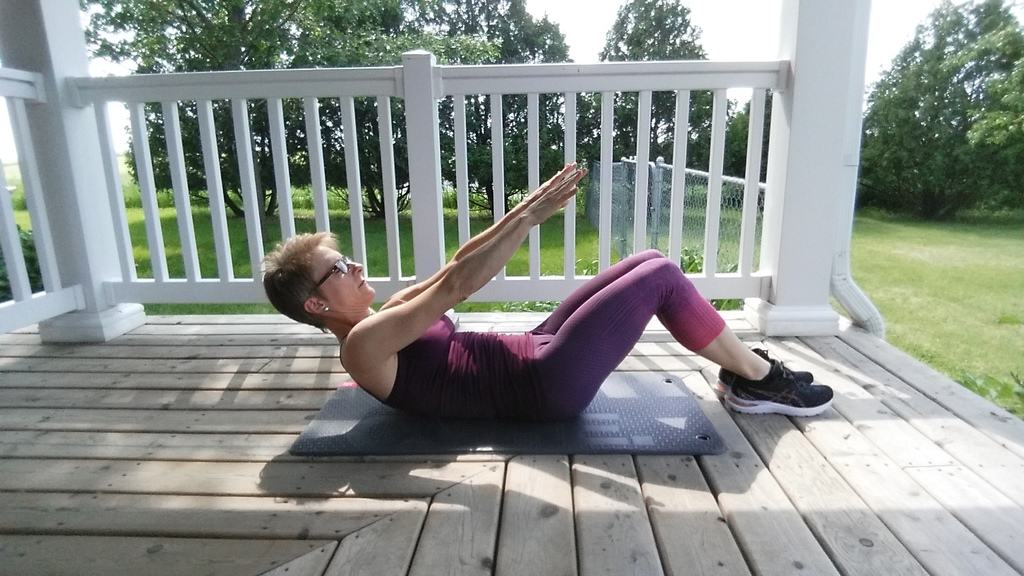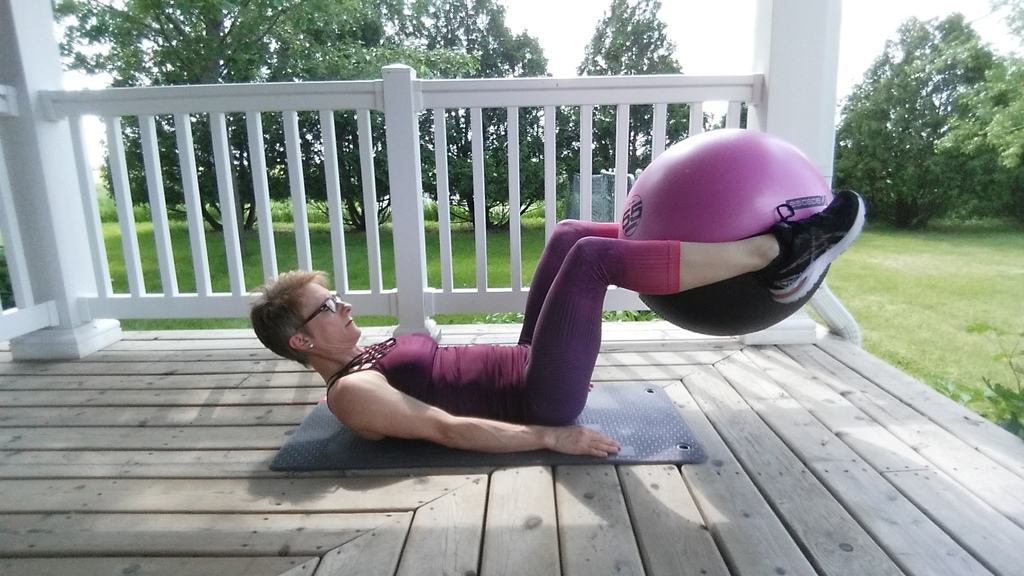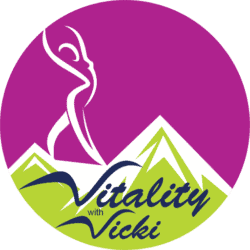 The core of our body is its foundation. Just like the foundation of a house, it’s what holds it all together. For that reason, I think it’s the most important area to strengthen right away. So I’ve come up with 6 easy core exercises you can do at home with (or without) a stability ball for variety.
The core of our body is its foundation. Just like the foundation of a house, it’s what holds it all together. For that reason, I think it’s the most important area to strengthen right away. So I’ve come up with 6 easy core exercises you can do at home with (or without) a stability ball for variety.
As a personal trainer working with women over 40, I’ve noticed some common core weaknesses in many of my clients. Before I start working with someone I check to see if they can do sit-ups, push-ups, or a plank. So far, most can’t do a single sit-up or push-up, but some can get into a high-butt plank (which technically isn’t a plank, but it’s a start!).
As I explained in a recent article, any good workout should include cardio and strength training, then stretching. The strength part of a workout involves lower body, upper body, and core exercises. But the core is the most important because it helps stabilize the rest of the body and protects the spinal cord.
Without good core strength, it can be easy to get injured while doing any physical activity. That includes the everyday activities of daily living in your own home. So if you start by improving your core strength everything else will come easier for you.
These 6 core exercises don’t require a stability ball at all. But using one does make some of them easier to do and more comfortable. It’s such an inexpensive accessory that can add some fun and variety to your at-home exercise routines. And that helps with motivation!
Let’s start with what exactly the core is and specifics on why it’s so important.
What is the “core”?
People generally think of the “core” as the abdominal muscles at the front of the body commonly known as the 6-pack. But many more muscles are included in our core, which really is our entire torso. The 6-pack is just the Rectus Abdominus muscles that go up and down the front of the torso.
Also included in the front side of our core are the Transverse Abdominus (TA), the Obliques on our sides, and the pelvic floor muscles. All of these muscles need to be strong for balance and mobility.
The TA, a.k.a “nature’s weight belt”, wraps horizontally around our waist and pulls the belly button in. The Obliques are on the sides of our torso and help us with twisting or side-bending movements. And the pelvic floor muscles are important so we don’t find ourselves peeing a little every time we jump or laugh!
In addition, we also have back muscles that help to support our bodies. The Multifidi are a series of muscles along the spinal cord that help take the pressure off our vertebrae. When they get weak and replaced by fat, back pain can result.
Finally, the Erector Spinae are a group of 3 muscles off to the sides of the spine. They help us to stand up straight and to bend backward or arch our backs.
These main muscles of our core work together to help us to move easily and safely. They all have different functions but they work as a unit mainly to protect our skeleton. Core exercises focus on this entire area to strengthen our muscles so we can move without injuring ourselves.
How to reduce fat in your core
We all need some fat in our bodies to survive. It’s one of the necessary “macronutrients”; carbohydrates, protein, and fat. Unfortunately, Americans have much more abdominal fat than is actually healthy for us. And it gets worse as we age!
Abdominal obesity is associated with a higher risk of all diseases and mortality. For better health, women should have a waist that is less than 35 inches and men less than 40 inches.
If you want to reduce the fat in any one area of your body then you have to exercise your entire body and eat fewer calories. Spot reduction DOES NOT WORK! By that I mean you can’t reduce the fat in just one body area. I’ve learned that many people still think doing lots of core exercises will get rid of the fat in their abs. This is untrue.
To reduce overall fat with exercise you need to do cardio because moving burns calories. But you also need to build muscle with strength training while you’re burning fat with cardio. Muscle raises your metabolism rate, so combining these two forms of exercise will give you the most benefit.
But if you also reduce your caloric intake your body will have fewer “extra” calories to store for later use. If you don’t ingest those calories to start, then you don’t have to worry about burning them off later. Those “extra” calories are above and beyond what we need for our normal activities, which is why they get stored away.
Reducing abdominal fat will lower your risk of most diseases and help you to feel better. When you feel better, you’ll have the energy to move more so you can get stronger. And strength is what we need to live happier lives with less pain!
My list of easy core exercises to do at home
Now the question is what easy core exercises can we do at home to help improve our strength and burn some calories? I’m into easy because I want average people to actually follow through and do the exercises! The harder ones can be for those who are more advanced exercisers or in training for a sport.
I also always feel that the less equipment you need to use the better. But in some cases, like with core exercises, a stability ball can be very helpful and more comfortable. It also makes it a little more fun! So use it if you have one but don’t worry about it if you don’t.
And remember, if any of these exercises cause you pain, then don’t do them. You should see a doctor to identify the problem and learn how to resolve it.
Here’s my list of 6 easy core exercises you can do at home with or without a stability ball.
-
- Shoulder raise on the floor (or “ab crunch” on the ball)
- Reverse crunch on the floor (or ball lift)
- Side bridge on the floor (or side crunches on the ball)
- Quadruped with raised knees on the floor
- Bird dog on the floor (or on the ball)
- Back extensions on the floor (or on the ball)
How to do them

The shoulder raise is a better version of the “ab crunch” from the old days! Lie on the floor on your back with your knees bent. Lift your arms up pointing your hands above your knees. Then raise your head and shoulders off the floor bringing them toward the ceiling. Don’t pull your chin to your chest, keep some space between the two. Then lower back down and repeat 10-20 times.

You can do the same thing on the ball with your lower back being supported by the ball. Just lift and lower your shoulders off the ball.

For this one, start by lying on your back on the floor with your knees bent. With your lower back pressing into the floor raise your knees up toward your chest and hold your head up if you can. Try to keep them at about a 90-degree angle the whole time. Then lower them down and touch your toes to the floor before raising them up again. Repeat 10-20 times.

You can do that same exercise with the stability ball held between your legs. This adds just a little extra weight to lift.

To work your obliques, lie on the floor on one side with your knees bent and your upper body supported by the lower bent arm. Now lift your hip up so your body is in a plank position from your knees to your head. You can either hold that position for up to one minute or you can lift your hip up and down 10-20 times.

A different version of that same oblique exercise can be done on the stability ball if you’re willing to work at it a little more! Kneel to the side of your ball, then lean your hip onto the side of the ball. Keep your lower leg bent for balance and your upper leg straight out. Then reach your upper hand toward your knee while staying in a side position on the ball. Repeat this reaching 10-20 times.

This is a precursor to the full plank because it still builds up your core strength while being easier than the plank. Get on the floor on your hands and knees (quadruped position) then flex your toes forward so you can get up on them. Now raise your knees slightly off the floor and hold that position for up to one minute. No ball necessary here!

Here’s another exercise starting on the floor on your hands and knees. Once there, lift one arm and the opposite leg (bird dog) straight up and out then lower them. Switch to the other arm and leg and repeat that 10-20 times for each arm and leg lift.

The same exercise can be done on the ball but requires a lot more balance and therefore a lot more core strength! When using the ball your legs will be straight out rather than bent which takes more balance. So start on the floor if you need to build some strength before using the ball. The ball helps to support your body, but if you have a fairly large ball it can make this exercise harder to do. You’ll know what I mean when you experience it. Working with a ball takes practice!

For back extensions, lie on the floor on your belly with your arms relaxed over your head and bent. Then lift your arms and upper body up off the floor and lower again. This doesn’t have to be a high lift, just get them up off the floor. Repeat this 10-20 times.

The same back extension can be done using the ball too. Lie on your belly on the ball and put your hands behind your head. Make sure your feet won’t slide on the floor! Lift your arms and upper body up into an arched position then lower again. Repeat this 10-20 times.
Where to start and how to progress
Do these easy core exercises 2 days a week for about 6-8 weeks. Do as many reps as you can to start and work your way up to 10-20. You can also just start with one set of the exercises and work up to 3 sets. This routine is meant to be performed one exercise at a time moving through all six and then starting over with another set.
Once you feel like you’ve mastered these exercises you can move on to different and more difficult exercises because you’ll be stronger! Seeing progress is always exciting!
Be sure to stretch after doing these exercises. Stretching should always be done at the end of any workout.
Related article: Stretching for flexibility: Why it matters?
My final thoughts
You can see how these exercises are all easy enough to do at home. Just be sure to pay attention to my form in the pictures provided. If you don’t have good form, you’ll either hurt yourself or not work the right muscles.
And remember that the core isn’t just the abs but the entire torso from front to back. We need to exercise all of those muscles in order to have a strong foundation for our bodies. Without a strong core, we’re more prone to back injury and pain.
According to the American Chiropractic Association (ACA), “Worldwide, back pain is the single leading cause of disability, preventing many people from engaging in work as well as other everyday activities.” This is not the area of your body to take for granted no matter what your age!
As we get older it’s common to lose most of our muscle, but that’s not an inevitable part of aging. It’s caused by not using our muscles enough in physical activity. Sedentary jobs and lifestyles also lead to weak core muscles, so age really isn’t the problem at all. It’s how we spend our time.
Related article: Don’t let age define you!
If you want to spend your time enjoying life then start working on these easy core exercises today to improve your strength. The point of life is to live it to the fullest and to do that we need to be strong and pain-free!
Remember: this post is for informational purposes only and may not be the best fit for you and your personal situation. It shall not be construed as medical advice. The information and education provided here is not intended or implied to supplement or replace professional medical treatment, advice, and/or diagnosis. Always check with your own physician or medical professional before trying or implementing any information read here.

